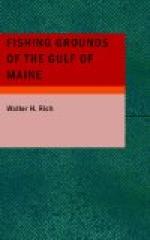The general contour of the bank within the 65-fathom line, as laid down on the Admiralty chart, approaches somewhat a very elongated ellipse, the longer axis running NE. by E. and SW. by W.; but over a broad area to eastward of the center of the bank, soundings of less than 50 fathoms connect it directly with the Middle Ground, which we have here included in the some bank. The total extent of the bank thus defined is about 7,000 square geographical miles. Off its eastern end lies Banquereau (the Quereau of the fishermen) with The Gully between, and a short distance of the western edge are the La Have Ridges.
The depths off the southern edge of the bank increase rapidly from 80 to 700, 1,200, and even 1,400 fathoms. At the eastern end is Sable Island, [16] “graveyard of ships”, a long, narrow, crescent-shaped elevation seemingly lessening in area each year, formed entirely of sand that has been blown Into innumerable hummocks and dunes. Off both ends of the island are long and dangerous sand bars. The length of the island is 20 miles; its greatest width is about 1 1/2 miles. It is said that the Northwest Light has been moved three times due to the fact that the western end of the island has been literally blown away. It lies in an E. and W. direction, and the depth of water over the bars for a distance of 7 to 10 miles out does not exceed 2 fathoms, and even 10 miles farther out the depths do not exceed 10 to 11 fathoms. Within recent years fishermen have reported the appearance of a sand shoal about 5 or 6 miles Se. from the Northeast Light. This is said to appear at low water.
In general, the bank slopes S. and W. from the island, depths ranging from 18 to 60 fathoms. The bottom is mostly sandy with patches of gravel and pebbles. Currents are sometimes very strong about Sable Island and are somewhat irregular; apparently they are much influenced by the winds. On the other parts of the bank usually there is but little current, whatever there is usually tending toward the west.
Formerly the cod and halibut were the food fishes most taken here, but with the changed methods in the fishery (as the growth of the otter-trawl fleet) and a changed taste in our public the haddock catch has become the second most important in the receipts of fish from these waters. The halibut fishery stands third in the list. Other bottom feeders occur in less numbers, the pollock and the cusk perhaps being next in order of importance, with hake and a considerable amount of the various flatfishes in the otter trawls. These latter are marketed as sole.
Noting the small amount of haddock in the fares taken from these waters in former years, the writer asked a number of old-time fishermen as to its abundance in the old days. The reply was usually “Oh, yes, there were always haddock there; sometimes they bothered us a lot.” Then, noting my surprise at so putting it, “You know, the haddock isn’t much as a salt fish.”




